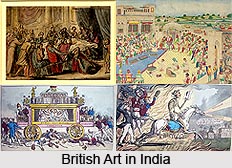 vIndian art and craftwork during British rule had witnessed an all-round upliftment, with the government of India incorporating some regulations to boom artisans. Schools and colleges and even exhibitions were formed to make art and craft work easier to common man. British hands were also involved, which made such works earn pride place in British museums.
vIndian art and craftwork during British rule had witnessed an all-round upliftment, with the government of India incorporating some regulations to boom artisans. Schools and colleges and even exhibitions were formed to make art and craft work easier to common man. British hands were also involved, which made such works earn pride place in British museums.
In the prolonged years of 1850 to 1875, British developed a number of art schools for training Indian artists under the aegis of the Department of Public Instruction. The schools founded included: Madras - 1850, Calcutta - 1854, Bombay -1857 and Lahore - 1875. Lockwood Kipling (1837-1911) served as Principal of the Mayo School of Arts at Lahore from 1875 to 1893. His programmes as did the others prepared graduates as professional portraitists, lithographers, illustrators, ornament designers, draftsmen and photographers. Kipling further made a serious effort to save or stimulate traditional Indian skills in wood-carving, furniture making and metal work. The interests and general attention paid to William Morris was also had a complementary role to the interest in India for arts and crafts.
In 1851, the Great Exhibition at London`s Crystal Palace stimulated considerable interest among the English towards Indian arts and crafts. Illustrations of Indian textiles, metalwork, woodwork, jewellery and enamels were displayed.
In 1857, the South Kensington Museum was founded and in 1899 emerged as the Victoria and Albert Museum. Within its collections was the noteworthy Indian Section. In 1875, the Museum acquired the artefacts held by the former British East India Company and thus became Britain`s pre-eminent collection of Indian artefacts. The status of Indian art and craft under British rule was extremely promising, when English people gradually attracted towards ancient Indian finery to make it thus known to the world.
Within the years of 1878 to 1884, Frederick S. Growse (1836-1893), Collector of Bulandshahr, displayed in enthusiasm his collection in Indian arts and crafts. Using only Indian designs he reconstructed Bulandshar`s town hall. His passion for Indian designs, however led him into conflict with his bureaucratic seniors.
In 1883, the Government of India actively sought to encourage the arts and crafts movement in India. A major exhibition was the government also sponsored the publication of the illustrated Journal of Indian Art and Teaching.
In 1886, a Royal Commission was organised, led by the Prince of Wales. The Commission organised the Colonial and Indian Exhibit in London. Indian art and craft under British rule was looked into seriously, later also to rope in Indian natives to create history by just handiwork.



















